By Kate Christensen
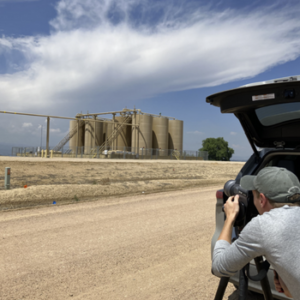
Andrew from Earthworks uses a special camera to detect pollution
There’s an odd collective experience that is only true in recent memory: meeting someone in person for the first time that you’ve only met over zoom. That experience happened at the end of July when Katie and I got to join Andrew Klooster in the field.
Andrew is a Colorado Field Advocate with Earthworks, who is working to end oil, gas and mining pollution. He travels around the state with his high tech camera, finds oil and gas sites that are malfunctioning and reports them. He is the person who residents call when they are feeling sick and have nowhere to turn. We got to go on a scouting mission in Weld County to see if we could find any leaking oil and gas sites.
Oil and gas sites are easy to miss if you’re not used to looking for them. They’re painted beige to blend in with the high plains desert landscape. The pollution is even easier to miss because it is often invisible to the naked eye.
Using an Optical Gas Imaging Camera to Detect Invisible Oil and Gas Pollution
What is an OGI camera and how does an OGI camera work? Andrew uses an optical gas camera (OGI) to find pollution that we can’t see with the naked eye. OGI cameras do this by measuring infrared energy. Infrared energy is a part of the electromagnetic spectrum and behaves similarly to visible light. His camera picks up methane and other emissions from oil and gas sites. (I highly recommend checking out some of Andrew’s blog posts like this one and this Colorado Times Recorder article for more information.)
We checked out ten sites in several hours while out with Andrew. We found at least two with concerning pollution. That is pretty typical for Andrew.
On average he reports 20-30% of all the sites that he observes to the Colorado Department of Public Health because he has observed emissions that could point to violations of air quality regulations. This is significantly higher than the leak rate reported by the oil and gas industry, which hovers around 3-4%. It is also incredibly alarming because we have so much drilling in Colorado.
We have over 50,000 active wells and if 20% of them are leaking that is an enormous impact because what they’re leaking is natural gas. Natural gas is methane. Methane is 80 times more potent of a greenhouse gas than carbon dioxide.
Oil and Gas Pollution Occurs for a Variety of Reasons: Equipment Malfunction, Human Error, or Equipment Degradation
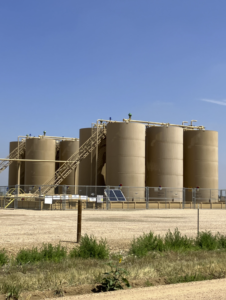
Fracking site, Weld County
Common sense would suggest that older tanks and wells would leak more often than the newer facilities. That is not what Andrew has found. He sees common pollution at all types of wells. That is because emissions occur for a variety of reasons. Equipment malfunction is one reason (a compressor stops working for example), human error is another reason (maybe someone left a valve open), or equipment can degrade (tank battery cracked). All of the above and more are normal occurrences at an oil and gas facility.
When Andrew goes out in the field he is at a major disadvantage when compared to the state regulators. He is only allowed to film sites from public locations like sidewalks and roads. This is less than optimal for a few reasons. First, we have to worry about trucks speeding by and just general safety. Second, sometimes pollution and a heat signature can look very similar from a distance and it is not always possible for Andrew to get close enough or to get the angle that would help him distinguish between the two. Lack of access is concerning because there are many, many wells that Andrew can’t record. There was one we drove by, near a high school, that experts suspect is leaking terribly based on data from the AIR monitoring station near Union Reservoir in Longmont, Colorado. However, it is surrounded by private land and impossible for Andrew to get close enough to film.
Barriers Within the System: Colorado Only Accepts Pollution Reporting from State Regulators or Oil and Gas Companies
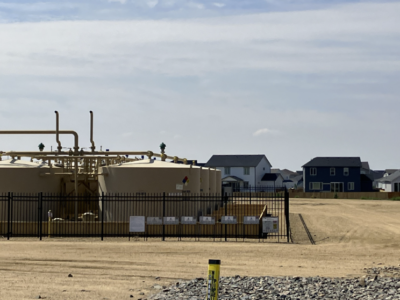
Neighborhood drilling, Weld County
Another barrier within this system is that the state will not accept Andrew’s recordings as evidence of pollution. They only accept OGI footage from our own state regulators or oil and gas companies. So, if Andrew sees something concerning, if it is not captured by one of the sources of information accepted by state regulators, even though the equipment is the same, they treat it like it didn’t happen. The same barrier exists for local governments (like Longmont, Broomfield and Erie) who are spending significant amounts of money on air quality monitoring. It’s good information for the public to have, but completely ignored by the state.
Therefore there is no enforcement and the oil and gas industry gets to police itself.
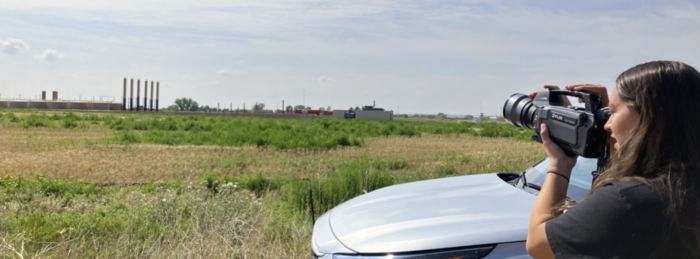
Katie Rodriguez assesses pollution at Weld County fracking site
The Air Pollution Control Division (APCD) responded to Andrew about the two sites we looked at.
Here’s what Andrew said:
“The Crestone Drieth site was shut in (not operating) when we looked at it so the emissions we saw from the valve were “breathing” emissions. If the site was operating they would most likely have been routed to the combustor to be destroyed but when a site is not operating the combustors are not operating so the tanks have to vent. In other words, this is pollution that is allowed to occur because oil and gas infrastructure is designed to pollute. Control measures are put in place to “control” but usually not outright prevent that pollution.
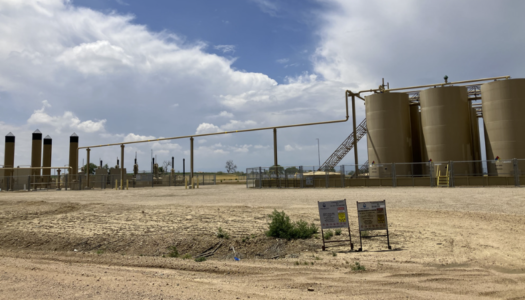
Weld County Fracking Site
For the Nickel Road Operating Noble site the operator determined the emissions we filmed were likely due to an upset condition (failure or malfunction of equipment or processes) and were an isolated event. If an upset was occurring when we filmed the site then the emissions we filmed would not constitute a violation of state rules because upsets are not always preventable by an operator. Again, what this means is that some amount of significant pollution is inevitable because oil and gas operations cannot guarantee that failures or malfunctions will not occur.
If an upset was not occurring, then this is a convenient shorthand for “nothing to see here” as no further investigation is warranted. So no further action on the pollution we observed from either site is possible, even in the state with the strongest oil and gas regulations in the country.”
Just to sum up – here’s the process most of the time:
Step 1: Andrew gets a video of an oil and gas site gone wild.
Step 2: Andrew files a complaint with the appropriate state agency, usually APCD and sometimes COGCC.
Step 3: Agency asks the oil and gas company to go check it out.
Step 4: Oil and gas company tells the agency “normal operations” or “nothing to see here.”
Step 5: Agency tells Andrew no further action is required.
Repeat.
Department of Public Health Closed an Oil and Gas Site for the First Time – a Small Win – But Continued Pressure is Needed
There was a major win recently – but it was the first and it was a rare exception. The Department of Public Health, for the very first time ever, closed an oil and gas site because it was malfunctioning and threatening public health. This win was, thanks in large part, to Andrew’s work. We need to shift the mindset at the state level. Right now regulators at the COGCC and the CDPHE/APCD see themselves as people whose role it is to rubber stamp permits to pollute. We need them to stop pollution when it occurs when it is threatening public health.
Until our department of public health actually starts regularly taking action to support public health here are some steps we can take:
- Tell the COGCC that you support the Cumulative Impacts Rulemaking Petition submitted by WildEarth Guardians, 350 Colorado, Womxn from the Mountain, Physicians for Social Responsibility, The Larimer Alliance, and Sierra Club. You can contact the COGCC at 303-894-2100 or email commissioners at jeff.robbins@state.co.us
- Contact local government officials about your concerns. We don’t have a good history of regulators listening to the concerns of average citizens. There is a stronger result if they get pressure from town councils and county commissioners.
- Legislative session is coming soon. Contact your state senator and state representatives and tell them that you want the state to take community evidence seriously. Regulators do not have the capacity to monitor all of the well sites that pose a threat to communities statewide. This would give more weight to evidence gathered by groups like Earthworks and local governments, like Broomfield and Erie, that are doing their own independent monitoring of oil and gas wells.
- Tell the Governor Polis that he needs to give direction to his regulators. He appoints the commissioners at the different regulatory agencies (COGCC, CDPHE, APCD). If he wanted them to take public health seriously rather than rubber stamping permits, and letting industry self-police, he could direct them to do so. So far, all he is saying is that the oil and gas permitting process is “legal.” You can contact the Governor here.
